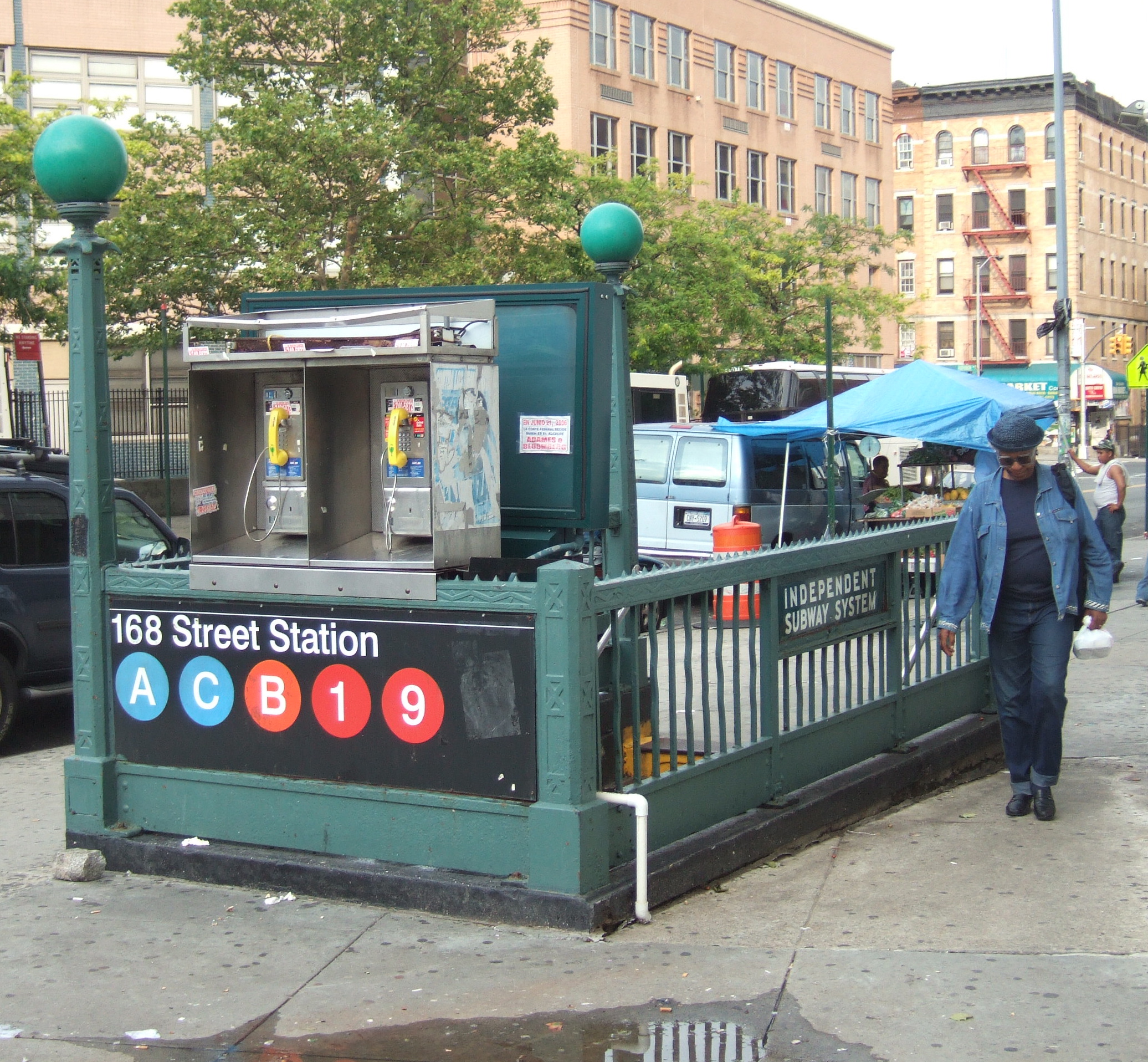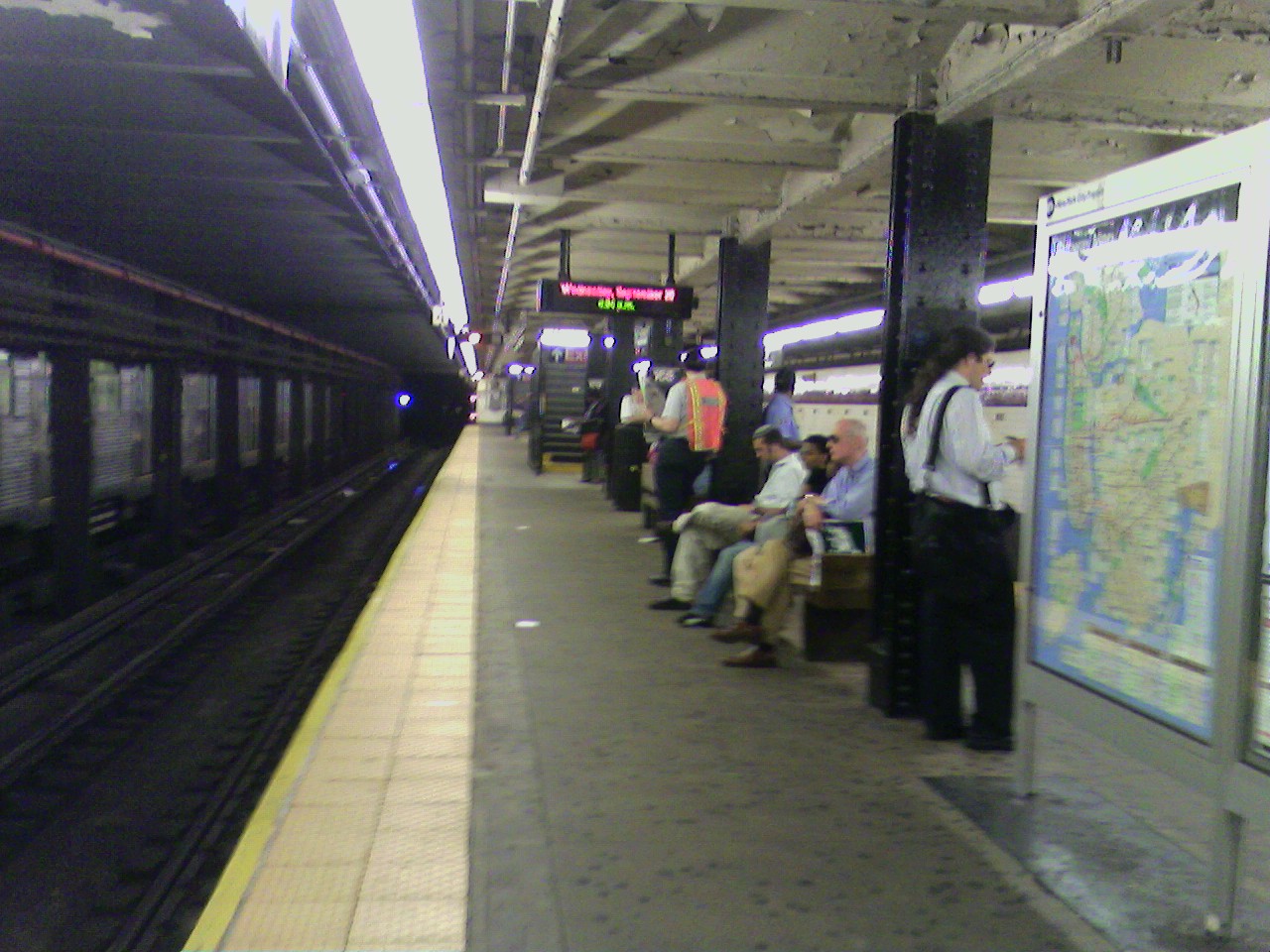- 168th Street (New York City Subway)
Infobox NYCS
name=168th Street
bg_color=black

service = Washington Heights-168th
time=1
passengers = 6.705 million
pass_year = 2006
pass_percent = 4
borough=Manhattan
accessible=yes
acc_note=IND Eighth Avenue Line platforms only168th Street is a
New York City Subway station complex shared by theIRT Broadway–Seventh Avenue Line and theIND Eighth Avenue Line . It is located at the intersection of 168th Street and Broadway in theManhattan neighborhood of Washington Heights.Nearby points of interest include the
New York–Presbyterian Hospital , theHudson River waterfront parks, and remnants of theAudubon Ballroom . Access to the station is available via staffed elevator, although the complex is not handicapped-accessible. In 2005 the station was added to theNational Register of Historic Places .__TOC__IRT Broadway–Seventh Avenue Line platforms
Infobox NYCS
bg_color = #E20F00

line = IRT Broadway–Seventh Avenue Line
service = Broadway-Seventh north
platforms = 2side platform s
tracks = 2
open_date =March 16 ,1906
north_station = 181st Street
north_line = IRT Broadway–Seventh Avenue Line
north_service = Broadway-Seventh north
south_station = 157th Street
south_line = IRT Broadway–Seventh Avenue Line
south_service = Broadway-Seventh north168th Street on the IRT Broadway–Seventh Avenue Line has two tracks and two side platforms. This deep station features four elevators and two bridges that crossover the tracks, connecting the platforms. There is a high arched tiled ceiling and incandescent lamps that are no longer in use. The elevator buttons show that the station is served by the NYCS|1, NYCS|A, and NYCS|B trains. The 9 was the skip-stop variant of the 1 until May 2005. The B terminated at this station weekdays until March 1998, when it switched northern terminals with the NYCS|C. These elevators are on the west side of the station and are used to access the fare control and the mezzanine for the IND platform. There is a closed stairway leading up from the extreme north end of the northbound platform leading to an unknown location. The original elevator shafts are still visible, there is a window looking into the shaftway. At the rear of the shaftway is a closed-off passage leading to the theory that the original elevators had separate front and rear exits for arriving and departing passengers. The original elevators were double-deckers, near the northern of the two crossover bridges. They were destroyed in the building of the IND and the space is now a vent chamber. The north overpass extends into the wall. By looking on top of the wall behind the overpass, one can see a gate leading to the elevators.
IND Eighth Avenue Line platforms
Infobox NYCS
bg_color = #11117D
accessible = yes

line = IND Eighth Avenue Line
service = Eighth north
platforms = 2island platform s
tracks = 4
open_date=September 10 ,1932 New York Times , List of the 28 Stations on the New 8th Av. Line,September 10 ,1932 , page 6]
north_station = 175th Street
north_station_acc = yes
north_line = IND Eighth Avenue Line
north_service = Eighth far north
south_line = IND Eighth Avenue Line
south_local_station = 163rd Street–Amsterdam Avenue
south_local_service = Eighth north local
south_express_station = 145th Street
south_express_service = Eighth north express168th Street on the IND Eighth Avenue Line has four tracks and two island platforms. Contrary to usual express station layout, the inner tracks serve the NYCS|C local trains while the outer tracks serve the NYCS|A express trains. This is to make it easier for C trains, which terminate here, to turn around and make the southbound trip. South of this station, the tracks cross over one another to form the regular local-outer/express-inner configuration. The inner tracks continue north under Broadway to 174th Street Yard.
The platform-level tile band is a reddish purple with black border, and there are no name tablets.
There are several fare control areas. The full-time entrance is at the east side of 168th Street and Saint Nicholas Ave with one street stair descending to the IND area. It points towards the start of the passageway that leads to the IRT elevators and newsstand. The part time side is at the at north end of 169th Street and Broadway/Saint Nicholas Avenue. It contains a former booth, around-the-clock
HEET access, and three street stairs. Currently, there is a full length mezzanine inside fare control, but evidence suggests there was another a full length passageway outside fare control. This passageway extended from the current 169th Street exit all the way down to the closed area at 167th Street at the south end of this station. The exits there, including two stairs to the platforms, were closed in the 1980s for safety reasons. This area is now used forNew York City Transit employees only.Bus connections
*Bx7
*M2
*M3
*M4
*M5
*M18
*M100References
External links
*NYCSubway ref|http://www.nycsubway.org/perl/stations?6:85|IRT West Side Line|168th Street
*NYCS ref|http://www.nycsubway.org/perl/stations?7:3171|IND 8th Avenue|168th Street
*Station Reporter — [http://www.stationreporter.net/168bway.htm 168 Street/Broadway Complex]
Wikimedia Foundation. 2010.
